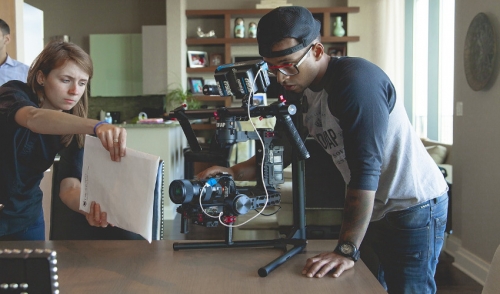
Become a Director and Make Your Own Online Videos
The song says, “Video killed the radio star,” and the truth is, video continues to dominate, especially on the web. According to an April study by the Interactive Advertising Bureau, 360 advertisers are spending an average of more than $10 million annually on digital video, an 85% increase since 2014. A 2015 report from Ericsson says the number of consumers viewing video on their smartphones has increased by 71% since 2012.
Websites like Vimeo and Youtube have made it easier than ever to share videos online, so it might seem like jumping in and filming with a smartphone just so you have a video on your website is a good way to get started. But that actually could end up hurting your business. While shooting the video yourself might save you some money, Hanley Wood video editor Jim Van Meer says that the quality of the video is something viewers can pick up on fairly easily.
“I feel like you can usually tell the ones that are DIY,” says Van Meer. “There’s just an entirely different aesthetic.”
Data also has shown that consumers have a negative image of brands with low-quality videos. A 2013 survey from online video company Brightcove found that 63% of consumers are more likely to have a negative perception of a brand that publishes low-quality video, and 23% of consumers would hesitate to purchase from that brand.
For those that do go with the DIY method, there are a number of technical hurdles to overcome. Smartphones are able to shoot video, but you’ll have fewer options for adjusting picture quality. Professional cameras can cost hundreds or even thousands of dollars, and could be an unwise investment if you aren’t going to be constantly filming.
You’ll also need to select one of the many video editing programs that are available, from default software like Apple’s iMovie to more advanced programs like CyberLink PowerDirector or Adobe Premiere. The features available on each program vary, so some additional research is required.
Van Meer also suggests that any DIY-er investigate the blog “No Film School,” which offers beginner resources like how to properly light a scene or how to complete basic editing. “Google’s your friend,” he says. “You really have to know what to ask at first. That’s the whole problem when people try to do it yourself; they don’t know what they don’t know. But if you’re at least asking questions, you’re probably on the right path.”
As for those that choose to hire professionals, websites like productionhub.com and staffmeup.com can connect you with crews in the area and let you post job listings. Van Meer also suggests that if you’re located near a college, see if it has a video program and find students who would be willing to help out for cheaper than most professional freelancers.
The length of each video should be tailored for its specific purpose: A video on your website giving visitors an introduction to your company may be best at a couple of minutes, while shorter videos can be more successful for social media sites that have autoplay settings as users scroll through their feeds. For those shorter videos, Van Meer suggests using text on the screen to catch those users who only see the first few seconds or have audio turned off.
The suggestions above might seem intimidating, but these are all things to know before deciding to attach a video to your company name. With a little planning, you can add a well-produced video to your site and boost your marketing presence.
“Really, it’s like any project,” says Van Meer. “You’re not going to start tearing down a house if you don’t have an end goal in mind, and you have to approach video the same way.”
